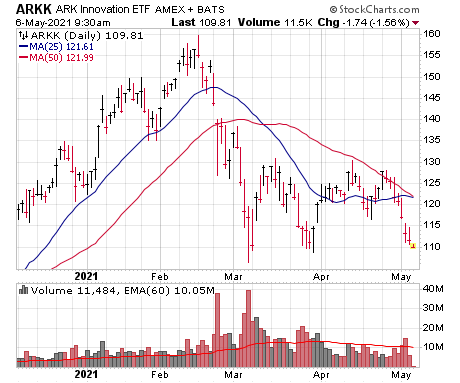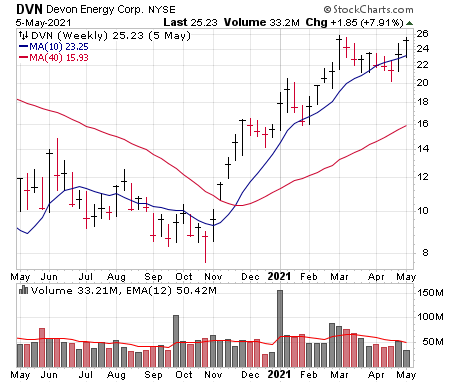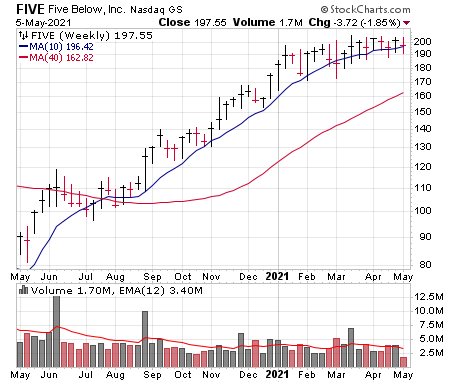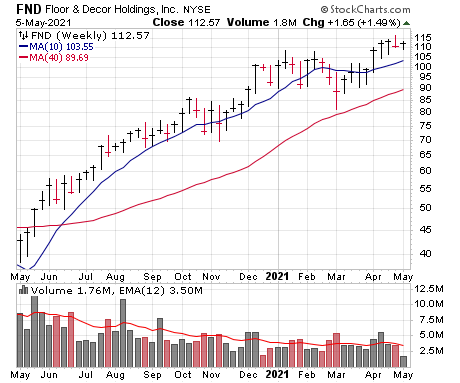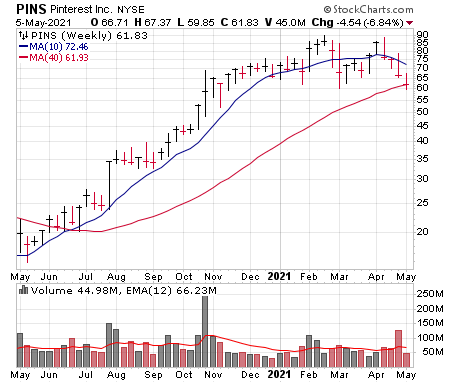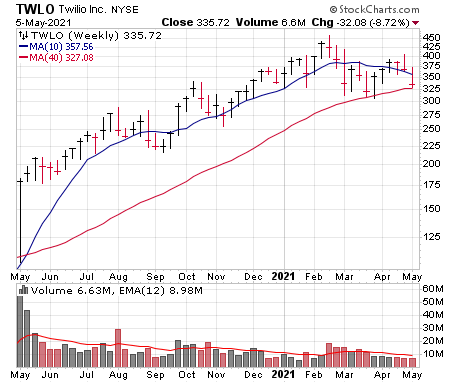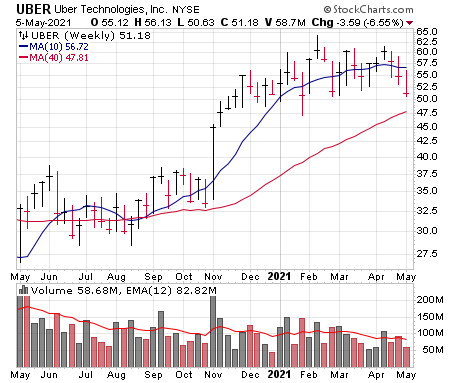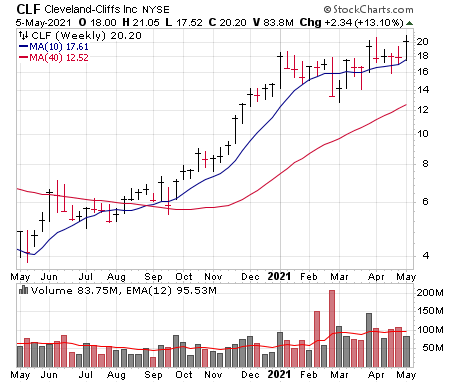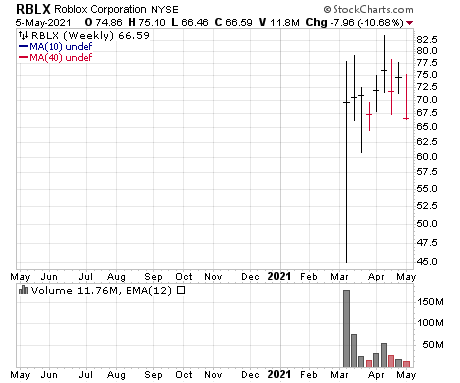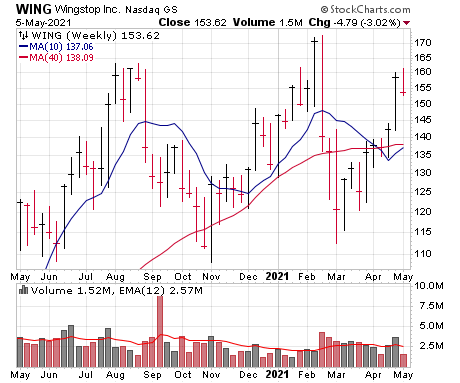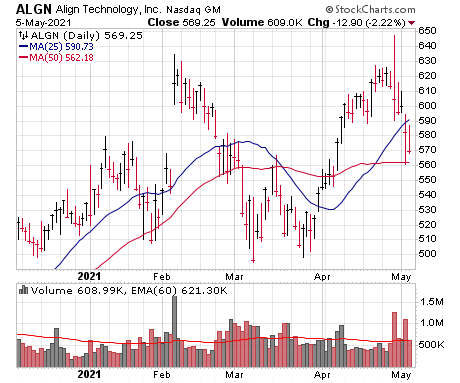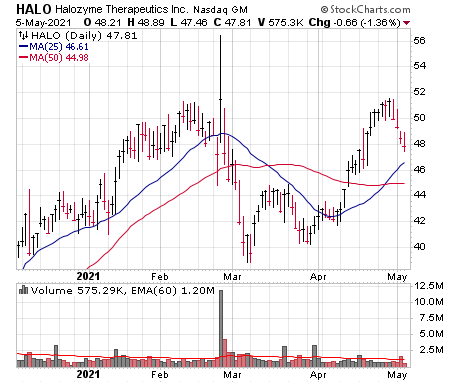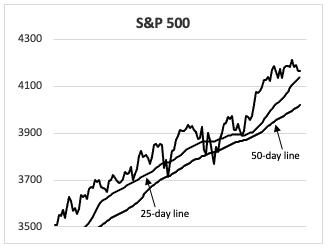Growth stocks had worked to set themselves up nicely in recent weeks, but all of that has fallen by the wayside, with names getting obliterated this week before and after earnings.
Despite an already-cautious stance, we’ve sold three more stocks this week, though we are nibbling on one new name in tonight’s issue. Even so, we’re content to remain defensive until the bloodletting stops.
In tonight’s issue, we write about one of the factors that thankfully kept us cautious of late, as well as dive into the energy sector, where the bullish thesis is playing out
Cabot Growth Investor 1471
[premium_html_toc post_id="229974"]
Back in the Soup
During the past month, the way we thought about what was going on was that growth stocks had finally put themselves into a position to get going after a two and a half month stretch of tough, choppy trading. Instead of narrow, volatile, brief ranges (as we saw during rally attempts in mid-March and early April), a bunch of names had set up nice-looking, three- to five-month launching pads ahead of their quarterly reports.
What was needed was some positive reports and outlooks to attract big investors and kick off some fresh, sustained uptrends. However, it just never happened—at no time was there ever evidence that buyers were flexing their muscles, with most stocks nosing to new highs doing so on little volume, most of which failed. (The rash of failed breakouts was one reason we never bought much into this rally; see more later in this issue.)
And this week, instead of positive earnings reactions, we’re seeing the opposite, with a bunch of former and potential leaders (PINS, SNAP, TXG, ETSY, etc.) cracking and possibly forming longer-lasting tops. The ARK Innovation Fund (ARKK—not recommended) provides a good view of what the glamour section of the market is doing. Not good.
Thus, for the here and now, we’re determined to remain cautious, and even defensive. While nearly any amount of investment in growth stocks has been too much of late, we’re glad to at least have had half our portfolio on the sideline in recent weeks, and that figure has gone up over the past few days as more names fall apart.
What about the future? Well, for the very big picture, we’re still bullish—the broad market remains in good shape, and while some massive winners from last year look awful, we’re not seeing widespread abnormal action. Even with growth stocks, a lot of names that have been dented at this point appear to “just” need more time. Said another way, there will be another growth stock run or two this year; the goal is to get from here to there with as much of your confidence and capital intact as possible.
Finally, there are cyclical stocks, which continue to trudge higher, but are already many months into their runs. However, while we’re not going to load up on no-growth, turnaround names, some areas (like energy stocks; see our writeup) seem to have the stories and numbers that could lead to a persistent run.
What To Do Now
All in all, our main advice is to respect what’s going on. In the Model Portfolio, that means making a bunch of moves—earlier this week we sold Pinterest (PINS), while earlier today we sold Twilio (TWLO) and Uber (UBER). Tonight, though, we’re going to put a smidge of our huge cash position to work in Devon Energy (DVN). That will leave us with a large 65% cash position, which we’ll hang onto tonight. Details below.
Model Portfolio Update
Growth stocks had been close to breaking free of this meat grinder environment for a couple weeks now, but every time there are a few rays of light, clouds reappeared—and since Tuesday, it’s been a bloodbath, with a bunch of leading titles imploding.
That doesn’t necessarily mean we’re in for some sort of long-term decline; some massive, older winners look very sick, but a lot of growth titles simply appear to need more time to set up. Eve so, given what’s out there now, a continued cautious stance is appropriate—less remains more for growth stocks, and until we see some definitive strength, we’re not in a rush to force things.
Earlier today we sold both TWLO and UBER, but tonight, we’re going to add a half-sized position in Devon Energy (DVN), which looks like a leader in the energy patch. We could have further buys or sells going ahead, but for now we’ll hold the rest of our outsized cash position.
Current Recommendations
| Stock | No. of Shares | Portfolio Weightings | Price Bought | Date Bought | Price on 5/6/21 | Profit | Rating |
| Devon Energy (DVN) | New | — | — | — | 25 | — | Buy a Half |
| Five Below (FIVE) | 852 | 8% | 138 | 9/18/20 | 192 | 40% | Buy |
| Floor & Décor (FND) | 1,004 | 5% | 107 | 4/9/21 | 113 | 6% | Buy a Half |
| Pinterest (PINS) | — | — | — | — | — | — | Sold |
| ProShares Ultra S&P 500 (SSO) | 1,741 | 10% | 60 | 5/29/20 | 114 | 90% | Buy |
| SelectQuote (SLQT) | 3,407 | 5% | 31 | 4/9/21 | 29 | -8% | Hold |
| Twilio (TWLO) | — | — | — | — | — | — | Sold |
| Uber (UBER) | — | — | — | — | — | — | Sold |
| CASH | $1,476,860 | 72% |
Devon Energy (DVN)—As we write later in this issue, we think energy stocks may be having a renaissance, and many have been consolidating for a couple of months and look ready to get going if the market behaves itself. We’re going with Devon Energy, a good-sized (market cap of nearly $17 billion) energy outfit with operations all over the place—the Delaware basin is by far its largest area of operations, but it also cranks out black gold in the Williston, Anadarko and Power River basins, as well as in the Eagle Ford shale. Output growth is likely to be modest going ahead (up to 5%), but with costs cut, cash flow here is enormous: In Q1, it earned about 59 cents of free cash flow (after CapEx), and it’s paying a chunk of that out (34 cent per share dividend coming in June). And that is just the tip of the iceberg: If oil stays at $60 per barrel, Devon’s management thinks it could produce cash flow north of $2.70 per share (11% of the current stock price, though just a portion will be paid out), and that’s including a bunch of hedges the firm is losing money on! Of course, while we’ll take a dividend check when it comes, we’re not income investors—but we think the potential for huge, sustained cash flow and payments (and debt reduction) has a good chance of enticing more big investors to build bigger positions, thinking the easy come, easy go character of the sector (and of DVN) has changed. Obviously, if oil prices collapse, all bets are off, but even $45 or $50 oil will produce a torrent of cash flow here. Like its peers, DVN went bananas from November through February, but has since etched a reasonable nine-week launching pad and is showing signs it wants to get going. DVN is volatile, and after such a big move, another wobble or two is possible, so we’ll start with a half-sized position tonight and use a loose stop in the 20 area. BUY A HALF
Five Below (FIVE)—We could pretty much copy and paste our past handful of writeups for Five Below here, as nothing has really changed—the story remains the same, with increasing foot traffic and store openings leading to a big rebound in business this year, while the stock continues to hack around in the 180 to 205 area (and more recently, the 190 to 205 range). What’s been interesting is the strength in “turnaround” retailers of late; similar to FIVE, investors are anticipating a big earnings upmove this year, and we’re all for the sector strength, which helps. But eventually we think the money will flow back to sustainable growth stories, where Five Below outshines most of its peers. Given the environment, we’re open to anything—it’s always possible the stock has hit a wall in the 200 zone that will create a larger decline, and if shares dip much from here, we could switch to a Hold rating. But we remain optimistic the next major move is up, as FIVE’s had many chances to give up the ghost but has been able to (mostly) resist the myriad air pockets out there. We’re continuing to hold on tightly to our shares, and if you don’t own any, we’re fine grabbing some shares around here. BUY
Floor & Décor (FND)—Given what’s going on in the market for any non-cyclical stock near its highs, FND’s action has been excellent—it’s been jerked around with everything else, but so far has etched higher lows and even snuck out to new price highs a few sessions ago. That’s encouraging, but tonight’s quarterly report will be key—analysts see sales up nearly 35% while earnings of 54 cents per share likely rose 59% from a year ago, but as always, there will be a ton of focus on the future in terms of foot traffic and construction industry trends, not to mention the pricing outlook (both in terms of costs and prices to customers, as the price of everything is heading up). Given some of the reports seen recently from homebuilders and macro indicators of renovation activity, the industry appears to be red hot, and besides, we’re just as interested in Floor & Décor’s long-term cookie-cutter outlook (20% store growth annually; it should be able to more than triple its number of locations in the U.S. alone), which gives big investors leeway to build good-sized positions. We’ll keep our Buy a Half rating but will key off earnings—a big positive reaction will probably have us averaging up, but a meaningful break of 100 or so would likely have us selling. BUY A HALF
Pinterest (PINS)—In the market, things can change quickly for better or worse, and Pinterest was a good example—three weeks ago, the stock was testing new high ground ahead of most growth stocks, prepping for a high-odds breakout if all went well. But … all did not go well, in fact, nothing did, with the stock soundly rejected at its highs, and then last week, the Q1 report was a dud. Beyond the chart action is our read of investor perception: While no one can be certain, management’s disappointing guide for user growth (U.S. users in Q2 might be down from a year ago!) reinforced the bearish view that the pandemic (and its forced stay-at-home lifestyle) was the main driver of last year’s business surge, so the future will be bleak. To be fair, earnings estimates are still going up as revenue-per-user is surging, but user growth was a key reason for PINS getting going last fall, and it’s what big investors are keying off of now. Any way you slice it, PINS’ action of the past few months looks ugly, and while a bounce is possible, there’s likely to be a lot of eager sellers on upticks. We had taken partial profits twice earlier and sold the rest of our stake earlier this week. SOLD
ProShares Ultra S&P 500 Fund (SSO)—On one end of the market you have growth stocks, which have been running through a minefield for the past two and a half months and have collapsed this week, with a bunch blowing up on earnings. On the other side is the broad market, which has been acting fine—not exactly soaring to the heavens but trading smoothly and “under control” as it makes its way higher. That’s helped indexes like the S&P 500 (and hence SSO) remain in firm uptrends, and while there have been a few air pockets (like this Tuesday), it hasn’t been difficult to ride the move higher. As for the here and now, the Tuesday decline found support near the 25-day line, while the more important 50-day line is still down near 105. As we’ve been writing for weeks, we’ll just follow along: A break of the 50-day line could have us selling some and going to Hold, but until that happens, we’re good with staying on Buy. BUY
SelectQuote (SLQT)—If the environment can right itself, we still think SLQT can enjoy solid upside as its growth stories play out. That said, the stock is being caught up in the growth stock selloff—before today the selling was tame, but it got a bit ugly today, though the drop came on extremely light volume and shares, while dented, are still near their mid April lows (much better than the Nasdaq). Of course, like everything else, earnings will be key—the company will release results next Tuesday (May 11), with analysts looking for a 75% hike in revenue and a 71% surge in earnings. Beyond the numbers, though, is the story, which lends itself to a lot of growth in the years ahead: SelectQuote is relatively rare merchandise, operating the leading insurance distribution platform, with a top position in Medicare-related and life insurance, demand for which is obviously going up in the years ahead as the population ages. And the firm isn’t just resting on its laurels—this week it announced its broadening its focus by launching Population Health, which will help seniors find primary care and pharmacy offerings (it also acquired a specialty medical management pharmacy), effectively leveraging SelectQuote’s huge lead generation operation to serve a whole new set of providers. Back to the stock, we don’t think SLQT is broken, but we also can’t ignore today’s move—we’ll switch to a Hold rating and see how the stock performs on earnings next week. HOLD.
Twilio (TWLO)—The “old” leaders of last year put on a nice rebound for three of four weeks, but that move is over, as many have collapsed before and after earnings during the past week or two. Twilio is the latest to have done so from this group, and the selling came despite some heady results: In Q1, sales lifted 62%, and while earnings of 10 cents per share were down 17% from a year ago, they trounced expectations of a five cent loss. Moreover, all of the sub-metrics were solid, including a 33% gain in same-customer revenue growth as usage of its core communications offerings (not to mention the new Segment business) surges. The outlook was also higher (though not gangbusters), but in this environment it wasn’t enough: TWLO gapped lower on the news, continuing its recent selloff and trading below its 200-day line. If you’re an optimist, you can say that round-number support near 300 is still being defended, which could lead to at least a bounce. But when combined with the horrid action among growth stocks and its peers, we’ve seen enough—we sold via a special bulletin earlier today. SOLD
Uber (UBER)—UBER was also sold via the special bulletin earlier today, and again, it was nearly the same situation with TWLO: The Q1 report was very solid, with gross bookings actually up 24% from a year ago, driven by a whopping 166% gain in Delivery bookings, with normalized revenue up 11% from the prior quarter (Delivery revenue up 230%!). EBITDA, while in the red, topped expectations as well. But it wasn’t enough, with investors instead keeping their focus on the U.S. decision to classify gig economy workers (like Uber’s drivers) as employees; management said it can handle the cost, but Wall Street is pessimistic, driving the stock toward its 40-week line and below our stop. Honestly, we still think UBER will eventually have a sustained run, and if it shapes up down the road we could take another swing at it. But the fact that it’s constantly run into resistance in recent months is a sign it needs more time, seasoning and clarity on its business and costs before big investors give it their blessing. SOLD
Watch List
- Halozyme (HALO 48): We’re still keeping an eye on Halozyme, whose story is unchanged, and whose stock appears to have digested the ill-timed $700 million convertible (dilutive) bond offering in late February (as growth stocks cracked). Earnings are due next Monday (May 10).
- Shockwave Medical (SWAV 145): On one hand, SWAV is a bit thin for our tastes and has had a big move over the past year. On the other, it’s one of the very few growth stocks to have tagged new highs in recent weeks. Earnings are out next Monday (May 10).
- Wingstop (WING 151): We already have two cookie-cutter stories in the portfolio, so we’re not sure we’ll add a third. But WING is setting up again after many months. See more later in this issue.
Other Stocks of Interest
Cleveland Cliffs (CLF 20)—Inflation is becoming the talk of Wall Street, with commodities of all sorts shooting up in price as demand explodes (and the economy rebounds in strong fashion) and supply issues remain (partly due to persistent virus-related lockdowns, especially overseas); combine that with all the stimulus (fiscal and monetary) and base material firms are raking in huge money. Cleveland Cliffs is one of our favorites in the sector—the company has long been a leading producer of iron ore (a key input into steel making), and it piggybacked off of that to become one of the leading steel plays out there thanks to an aggressive management that went on offense during the downturn, acquiring AK Steel and ArcelorMittal USA last year. And now the fully transformed company is firing on all cylinders: Earnings and cash flow have already begun to explode, and even with conservative pricing estimates (meaningfully below current and expected prices), management believes the firm will product $4 billion of EBITDA this year, which is about 40% of the current market cap! Of course, the question with these cyclical names is always how long will the good times last, but even with some pretty bearish 2022 outlooks (analysts see Cliff’s earnings north of $3 this year but being cut in half next), valuations are far from unreasonable and, after years in the doghouse (which led to cost cuts, industry consolidation and cutbacks), all of these Wall Street numbers will likely prove conservative in our view. And the stock seems to agree—CLF had a massive run through the end of last year (including rising 14 of 16 weeks) and has since etched a four-month launching pad that lately has seen a lot of tight weekly closes (usually a constructive sign). It’s a solid setup that should lead to higher prices as the inflation theme continues.
Roblox (RBLX 65)—If you have young kids, you almost surely know of Roblox, whose app is incredibly popular among grade schoolers, and the reason is that this isn’t just another game app but really a broad gaming platform. In our view, Roblox seems to have hit on something big—the company calls it “human co-experiences,” which in essence are a ton of different 3D games or experiences where people play or goof around together in a new form of social interaction, all with their own personalized 3D character. On the content side, what’s special here is that most of it is produced by developers who make these 3D worlds (along with avatar items other users will pay for, and some make tools and 3D models to help other developers do their own worlds), which creates and avalanche of new games to explore; all told Roblox has more than eight million active developers (!) worldwide, and they get “paid” in Robux, which can be spent on the platform or exchanged for real dollars. All in all, with 32.6 million daily active users that spent 30.6 billion hours on it last year, and that figure is growing rapidly. As for revenues, most of Roblox’s take comes from sales of virtual items and experiences on the platform, and the top brass thinks there’s huge upside there as the user base grows and as monetization efforts improve. Clearly, they’re doing something right: Revenue growth is both accelerating and growing at triple-digit rates (46%, 68%, 92% and 110% during the past four quarters), and while the bottom line is in the red, that should change this year (44 cents expected) and cash flow is already positive. The stock just came public in early March and has mostly chopped around since, but the stock is highly liquid and earnings are due out next Monday (May 10)—a big bullish reaction could put it on our official watch list.
Wingstop (WING 151)—One of the big questions going on in investment houses right now is: How will the end (or near-end) of the pandemic affect the business of so many “pandemic winners,” those firms that adjusted and thrived in the months after the shut-ins? Wingstop has always had a great longer-term growth story—it’s aim is to be a top 10 global restaurant brand, eventually aiming for more than 6,000 locations here and overseas (compared to 1,600 or so right now)—but because its business was already heavy on takeout orders (including a lot of online ordering), it thrived during the stay-at-home period, with sales (up 29%) and EBITDA (up 26%) actually accelerating last year and the restaurant count lifting 11%. Most expected a good-sized slowdown this year as the world turns right side up, but the evidence is pointing in the other direction: Last week’s Q1 report easily topped estimates, with sales up 28%, driven by a 21% gain in same-store sales (digital sales make up north of 60% of orders) while EBITDA was up 46% and the restaurant count was up 11.7% from a year ago (opened 41 new locations in Q1; expects more than 11% unit growth for the full year). The stock has been up and down since last summer, but that may now be a good thing—the major shakeout below its 40-week line into March of this year likely kicked out the remaining weak hands, and WING has seen some good-volume upside. There’s still overhead to chew through, but it’s looking like the past eight months has been one giant, tedious base-building effort and the long-term growth story remains on track.
Failed Breakouts are a Key Market Measure
We’re not necessarily breakout players—yes, sometimes we’ll buy soon after a stock lifts to new highs if it shows great power, but oftentimes we’re looking for other setups like early-stage pullbacks or some tight action. Even so, monitoring how growth stocks act when they attempt to break free of a multi-month consolidation is useful. Jesse Livermore used to call it the “Pivotal Point,” and how a stock acted as it tried to push through it told him a lot about the stock’s health—and in turn, the market’s.
Granted, it’s hard to exactly quantify the action; there’s no simple indicator that can tell you how attempted breakouts are faring. But if you keep your eye on enough high-quality growth names, you will get a feel for whether buyers are eagerly lifting things past resistance, or whether big investors are using such moves as an opportunity to sell.
The bad news: Even before the plunge of the past three sessions, it was clear that institutions were unloading on (or soon after) any move to new highs in growth stocks. The examples were endless but take a look at Align Technology (ALGN) and HubSpot (HUBS), which tell you what’s been going on.
ALGN had etched a nice, early-stage base (original breakout just back in October), saw some decent upside volume in early April and initially gapped up on earnings (sales up 62%, earnings up 241%; analysts still see a near-doubling of earnings this year) before reversing hard. Then there’s HUBS, which gapped up on earnings in February before building a base with the growth sector over a couple of months. The breakout attempt again had solid volume, but you can see what big investors did after that move, with shares cascading back into their base.
Now, all of this is descriptive and not necessarily predictive—a ton of growth stocks are reporting earnings starting today through next week, and if we see a rash of big, positive upmoves (and there’s not immediate selling afterwards), then it could be the start of a change in character. It’s not hard to find halfway decent setups despite the recent selling; old friend Halozyme (HALO) is a good example of a stock reporting next week (May 10) that’s set up nicely.
But you have to see it to believe it, and so far, seeing so many low-energy, failing breakouts is a sign of an unhealthy environment.
The Oil Stock Thesis is Playing Out
Commodity prices, and hence commodity stocks, have been doing well for the past few months, and that’s clearly one reason we’re keeping a close eye on a handful of energy stocks; given the cutbacks as many weak players went out of business, it wouldn’t surprise us if oil and gas prices remain elevated for a long time to come.
However, we think there’s a lot more to the story here than just elevated oil prices. As we’ve written before, the exciting, perception-altering part of this story is that explorers have learned their lesson from the heydays of a few years back: Instead of emphasizing debt-driven production growth and drilling like mad, nearly all are restraining costs (fewer drilling rigs, etc.) and growing production at single-digit rates, leading to a torrent of free cash flow (after CapEx) that’s being used to cut debt, pay dividends and buy back shares.
And based on Q1 reports, that’s exactly what is playing out. Diamondback Energy (FANG) saw free cash flow of $256 million in the quarter and, including divestitures, sees about $1.15 billion in free cash flow for the year at $60 oil; that would be about 8% of the current market cap. And all of these figures are after Diamondback pays an already-solid dividend (2.0% annual yield).
Then there’s Pioneer Drilling (PXD), which cranked out about $245 million of after-dividend (1.4% annual yield) free cash flow in Q1, and expects something like $2.2 billion for the full year. Interestingly, while a lot will go toward debt reduction, the firm will initiate a variable dividend starting next year, paying out a good-sized chunk of whatever cash flow it earns in 2021.
It’s the same story with Devon Energy (DVN)—the market cap here is about $17 billion, but it paid off $730 billion of debt in Q1 (and will chop another $500 million off in Q2), is paying a bonus dividend in Q2 (34 cents per share total for the quarter) and, at $60 oil, thinks it will crank out north of $1.6 billion (nearly 10% of the current market cap) of after-dividend cash flow this year!
No, these aren’t classic growth stocks, but they seem like lucrative special situations whose cash flow stories could play out for a long time, which in turn will attract more big investors. We’re adding a half position in DVN tonight. BUY A HALF.
Cabot Market Timing Indicators
The environment remains treacherous for growth stocks, but the rest of the market remains in decent shape, with the major trends continuing to point higher, even as sentiment has backed off. We’re holding a ton of cash, but with our indicators leaning positive, we’re open to doing a little buying if things stabilize.
Cabot Trend Lines: Bullish
While growth stocks have been tedious going on three months now, we’ve never wavered from our view that the overall bull market remains healthy. The main reason for that: Our Cabot Trend Lines, which have remained steadfastly bullish since the middle of last year—last week, both indexes closed 11% to 12% above their respective 35-week moving averages, keeping the longer-term trend firmly up.
Cabot Tides: Bullish
Our Cabot Tides also remain in the bullish camp, with most major indexes (including the S&P 500) hovering above their lower (50-day) moving average. To be fair, a couple of indexes are mostly sideways at this point, and a few bad days could change things. But we never anticipate—right now, both the longer- and intermediate-term trends are pointed up.
Cabot Real Money Index: Neutral
It appears the choppy conditions have finally dampened investors spirits a bit—our Real Money Index has moved into neutral territory, as inflows into equity funds and ETFs have slowed during the past five weeks. It’s nothing definitive yet, though another couple weeks of outflows could be a solid contrary signal.
Charts courtesy of StockCharts.com
The next Cabot Growth Investor issue will be published on May 20, 2021.
Cabot Wealth Network
Publishing independent investment advice since 1970.
President & CEO: Ed Coburn
Chairman & Chief Investment Strategist: Timothy Lutts
176 North Street, PO Box 2049, Salem, MA 01970 USA
800-326-8826 | support@cabotwealth.com | CabotWealth.com
Copyright © 2021. All rights reserved. Copying or electronic transmission of this information is a violation of copyright law. For the protection of our subscribers, copyright violations will result in immediate termination of all subscriptions without refund. No Conflicts: Cabot Wealth Network exists to serve you, our readers. We derive 100% of our revenue, or close to it, from selling subscriptions to its publications. Neither Cabot Wealth Network nor our employees are compensated in any way by the companies whose stocks we recommend or providers of associated financial services. Disclaimer: Sources of information are believed to be reliable but they are not guaranteed to be complete or error-free. Recommendations, opinions or suggestions are given with the understanding that subscribers acting on information assume all risks involved. Buy/Sell Recommendations: All recommendations are made in regular issues or email alerts or updates and posted on the private subscriber web page. Performance: The performance of this portfolio is determined using the midpoint of the high and low on the day following the recommendation. Cabot’s policy is to sell any stock that shows a loss of 20% in a bull market or 15% in a bear market from the original purchase price, calculated using the current closing price. Subscribers should apply loss limits based on their own personal purchase prices.

